SUBARU LEGACY 2002 3.G Owners Manual
Manufacturer: SUBARU, Model Year: 2002, Model line: LEGACY, Model: SUBARU LEGACY 2002 3.GPages: 466, PDF Size: 4.35 MB
Page 381 of 466
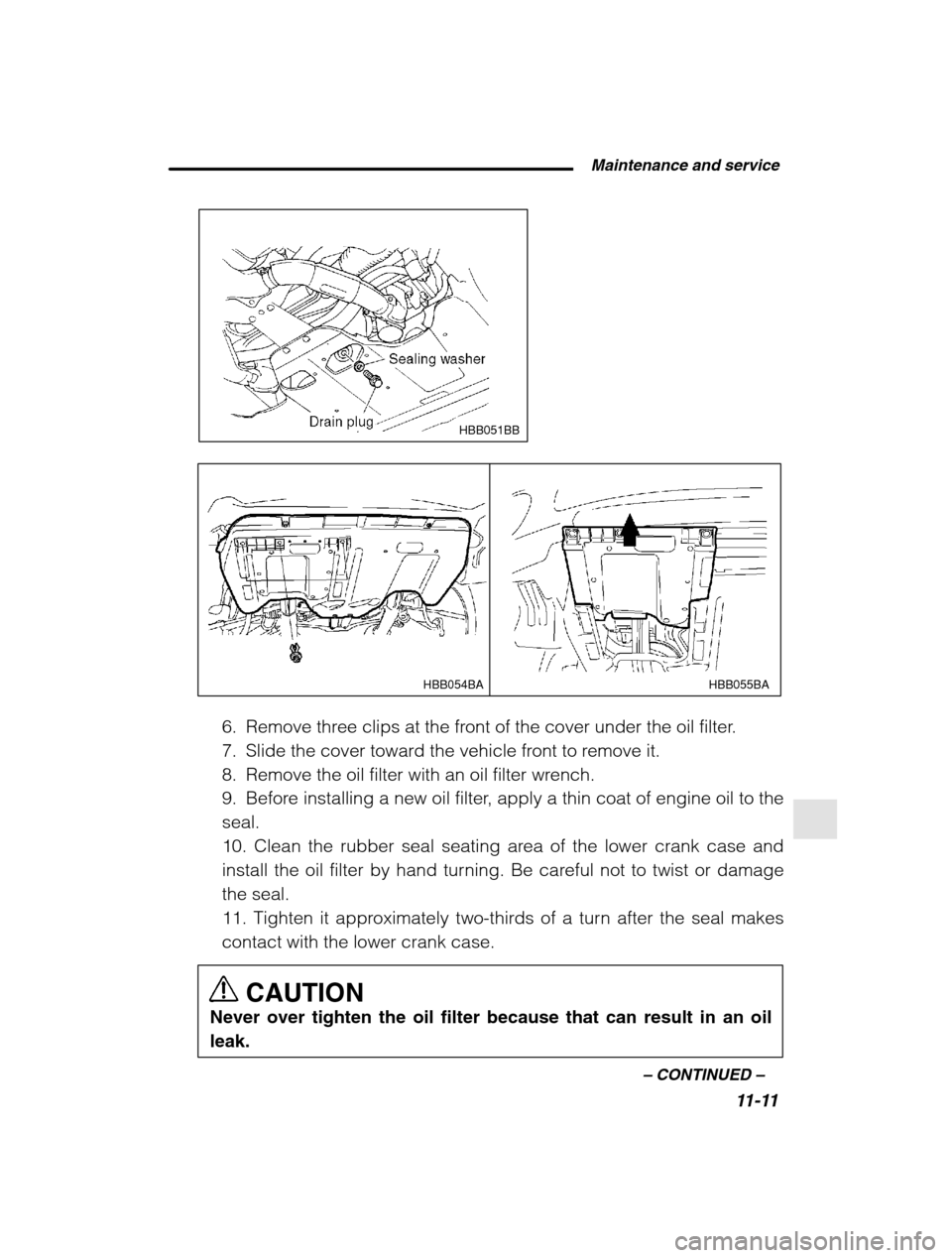
Maintenance and service11-11
–
CONTINUED –
HBB051BB
HBB055BA
HBB054BA
6. Remove three clips at the front of the cover under the oil filter.
7. Slide the cover toward the vehicle front to remove it.
8. Remove the oil filter with an oil filter wrench.
9. Before installing a new oil filter, apply a thin coat of engine oil to theseal.
10. Clean the rubber seal seating area of the lower crank case and
install the oil filter by hand turning. Be careful not to twist or damagethe seal.
11. Tighten it approximately two-thirds of a turn after the seal makes
contact with the lower crank case.
CAUTION
Never over tighten the oil filter because that can result in an oilleak.
Page 382 of 466
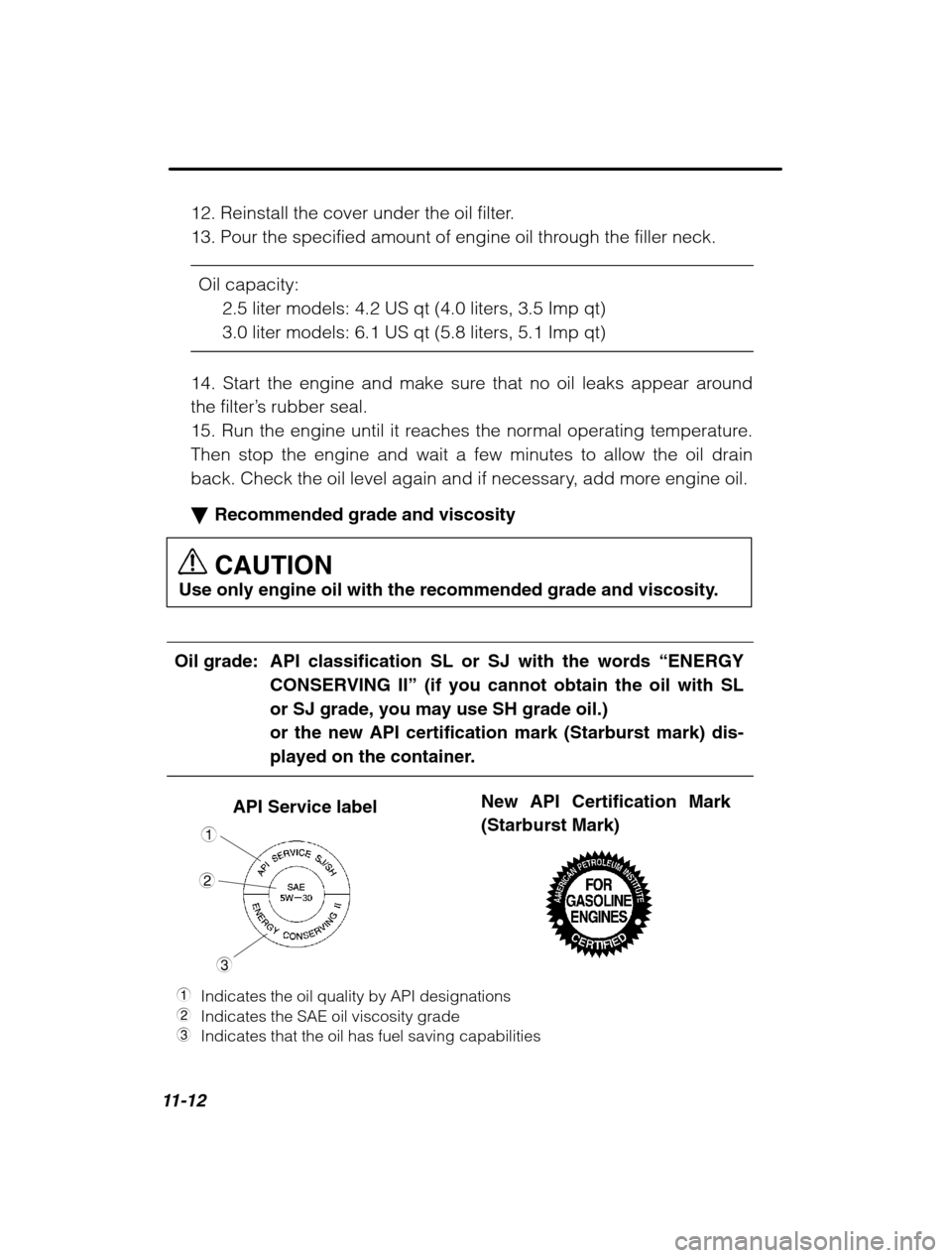
11-12
12. Reinstall the cover under the oil filter.
13. Pour the specified amount of engine oil through the filler neck.Oil capacity: 2.5 liter models: 4.2 US qt (4.0 liters, 3.5 Imp qt)3.0 liter models: 6.1 US qt (5.8 liters, 5.1 Imp qt)
14. Start the engine and make sure that no oil leaks appear around the filter ’s rubber seal.
15. Run the engine until it reaches the normal operating temperature.
Then stop the engine and wait a few minutes to allow the oil drain
back. Check the oil level again and if necessary, add more engine oil. � Recommended grade and viscosity CAUTION
Use only engine oil with the recommended grade and viscosity.
Oil grade: API classification SL or SJ with the words “ENERGY
CONSERVING II ” (if you cannot obtain the oil with SL
or SJ grade, you may use SH grade oil.) or the new API certification mark (Starburst mark) dis-
played on the container.
New API Certification Mark (Starburst Mark)API Service label
1
2
3
1 Indicates the oil quality by API designations
2 Indicates the SAE oil viscosity grade
3 Indicates that the oil has fuel saving capabilities
Page 383 of 466
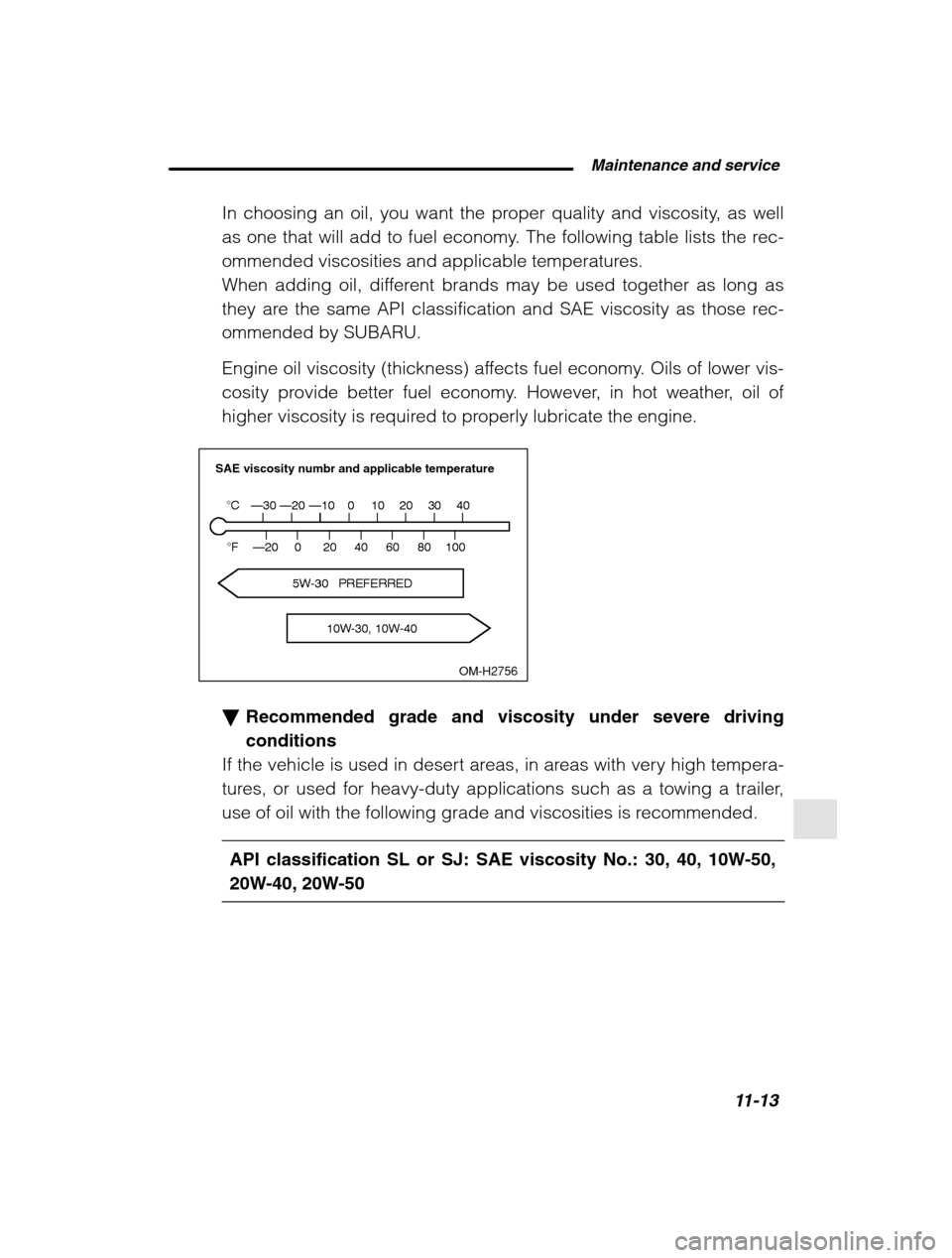
Maintenance and service11-13
–
CONTINUED –
In choosing an oil, you want the proper quality and viscosity, as well
as one that will add to fuel economy. The following table lists the rec-
ommended viscosities and applicable temperatures.
When adding oil, different brands may be used together as long as
they are the same API classification and SAE viscosity as those rec-
ommended by SUBARU.
Engine oil viscosity (thickness) affects fuel economy. Oils of lower vis-
cosity provide better fuel economy. However, in hot weather, oil of
higher viscosity is required to properly lubricate the engine.
OM-H2756
SAE viscosity numbr and applicable temperature
� Recommended grade and viscosity under severe driving conditions
If the vehicle is used in desert areas, in areas with very high tempera-
tures, or used for heavy-duty applications such as a towing a trailer,
use of oil with the following grade and viscosities is recommended.
API classification SL or SJ: SAE viscosity No.: 30, 40, 10W-50,
20W-40, 20W-50
Page 384 of 466
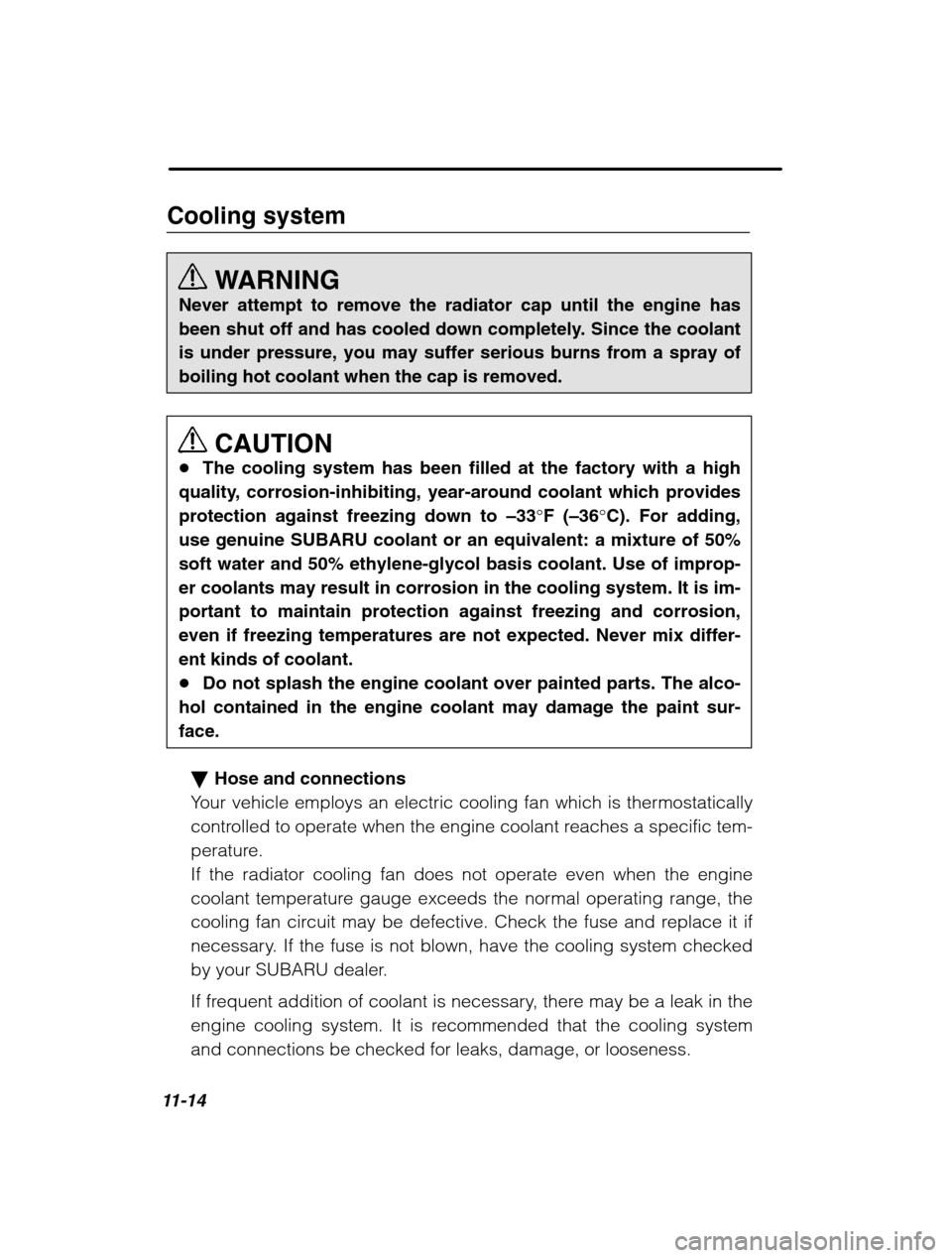
11-14
Cooling systemWARNING
Never attempt to remove the radiator cap until the engine has
been shut off and has cooled down completely. Since the coolantis under pressure, you may suffer serious burns from a spray ofboiling hot coolant when the cap is removed.
CAUTION
� The cooling system has been filled at the factory with a high
quality, corrosion-inhibiting, year-around coolant which providesprotection against freezing down to –33°F ( –36 °C). For adding,
use genuine SUBARU coolant or an equivalent: a mixture of 50%
soft water and 50% ethylene-glycol basis coolant. Use of improp-er coolants may result in corrosion in the cooling system. It is im-portant to maintain protection against freezing and corrosion,even if freezing temperatures are not expected. Never mix differ-ent kinds of coolant.� Do not splash the engine coolant over painted parts. The alco-
hol contained in the engine coolant may damage the paint sur-face.
� Hose and connections
Your vehicle employs an electric cooling fan which is thermostatically
controlled to operate when the engine coolant reaches a specific tem-
perature.If the radiator cooling fan does not operate even when the engine
coolant temperature gauge exceeds the normal operating range, the
cooling fan circuit may be defective. Check the fuse and replace it if
necessary. If the fuse is not blown, have the cooling system checked
by your SUBARU dealer.
If frequent addition of coolant is necessary, there may be a leak in the
engine cooling system. It is recommended that the cooling systemand connections be checked for leaks, damage, or looseness.
Page 385 of 466
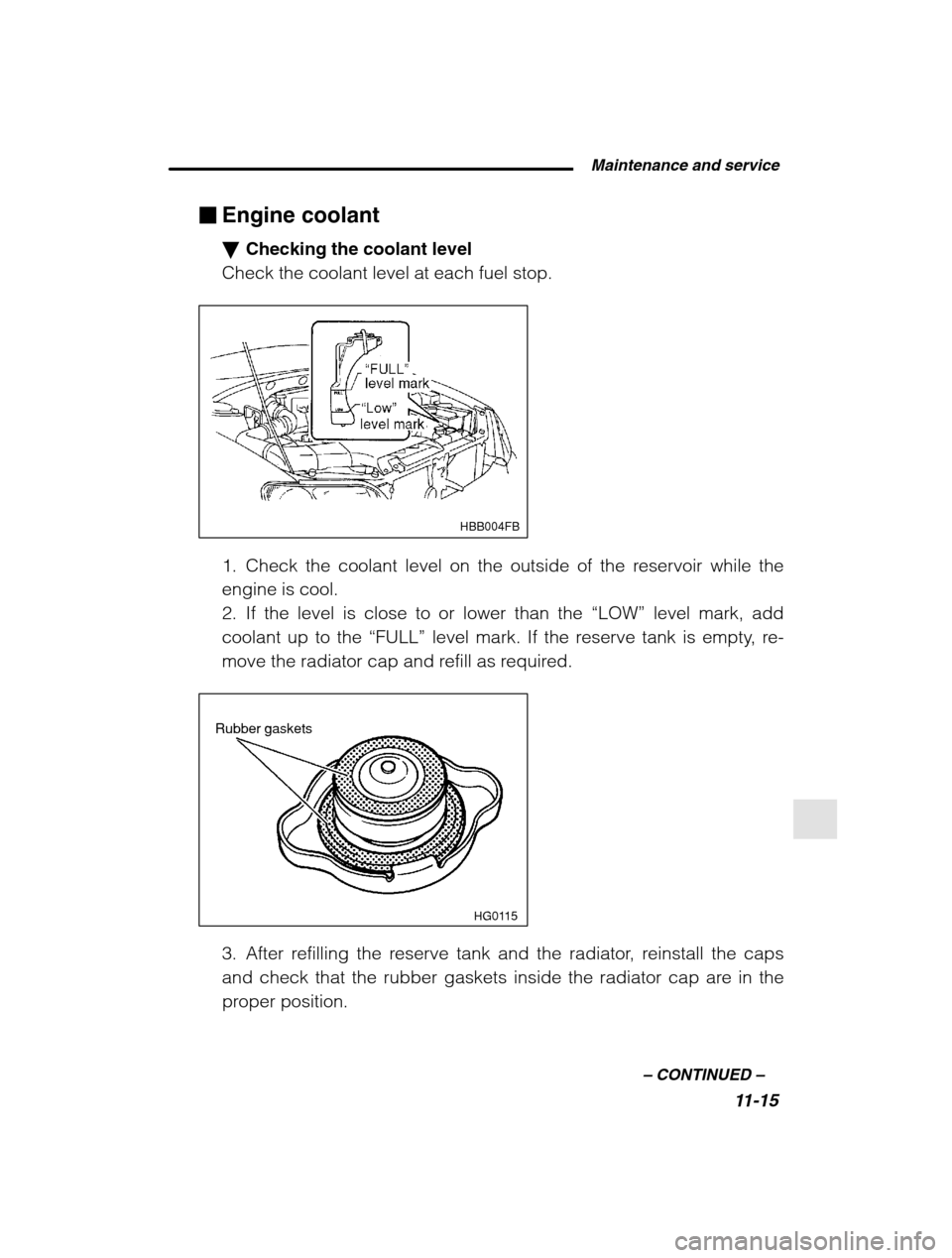
Maintenance and service11-15
–
CONTINUED –
�Engine coolant �Checking the coolant level
Check the coolant level at each fuel stop.
HBB004FB
1. Check the coolant level on the outside of the reservoir while the
engine is cool.
2. If the level is close to or lower than the “LOW” level mark, add
coolant up to the “FULL” level mark. If the reserve tank is empty, re-
move the radiator cap and refill as required.
HG0115
Rubber gaskets
3. After refilling the reserve tank and the radiator, reinstall the caps
and check that the rubber gaskets inside the radiator cap are in the
proper position.
Page 386 of 466
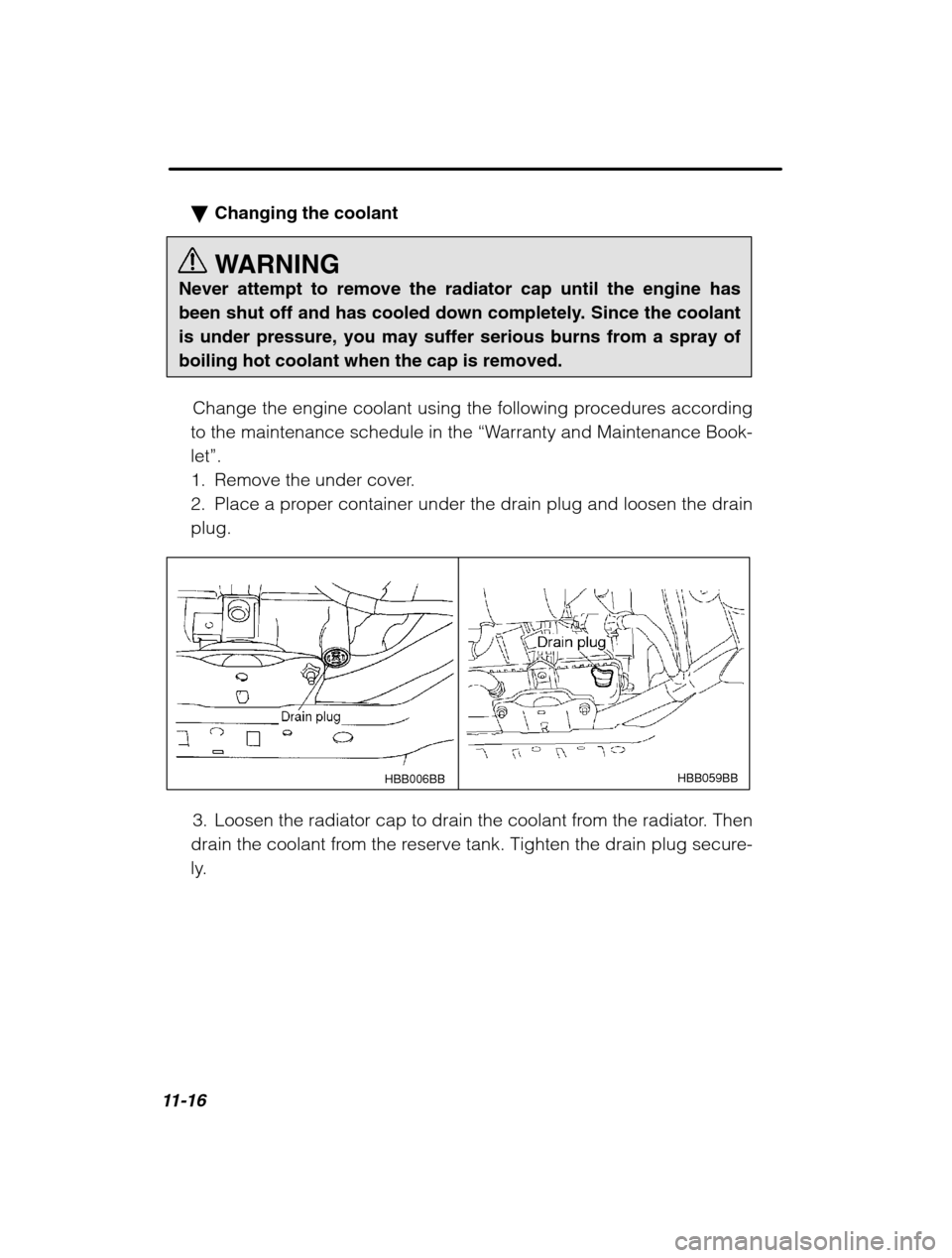
11-16
�Changing the coolant
WARNING
Never attempt to remove the radiator cap until the engine has
been shut off and has cooled down completely. Since the coolantis under pressure, you may suffer serious burns from a spray ofboiling hot coolant when the cap is removed.
Change the engine coolant using the following procedures according
to the maintenance schedule in the “Warranty and Maintenance Book-
let”. 1. Remove the under cover.
2. Place a proper container under the drain plug and loosen the drainplug.
HBB059BB
HBB006BB
3. Loosen the radiator cap to drain the coolant from the radiator. Then
drain the coolant from the reserve tank. Tighten the drain plug secure-
ly.
Page 387 of 466
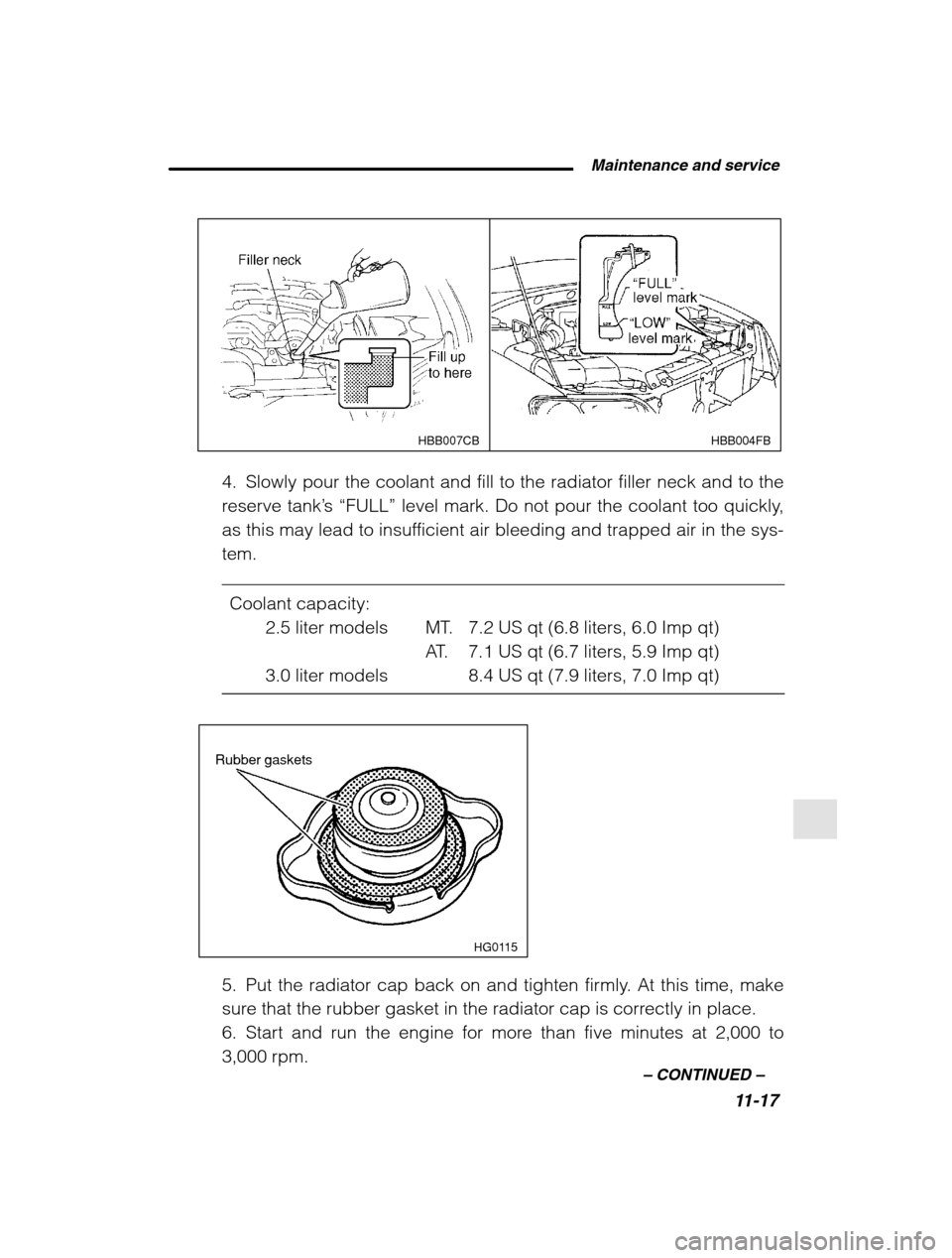
Maintenance and service11-17
–
CONTINUED –
HBB004FB
HBB007CB
4. Slowly pour the coolant and fill to the radiator filler neck and to the
reserve tank ’s “FULL” level mark. Do not pour the coolant too quickly,
as this may lead to insufficient air bleeding and trapped air in the sys-tem.
Coolant capacity: 2.5 liter models MT. 7.2 US qt (6.8 liters, 6.0 Imp qt) AT. 7.1 US qt (6.7 liters, 5.9 Imp qt)
3.0 liter models 8.4 US qt (7.9 liters, 7.0 Imp qt)
HG0115
Rubber gaskets
5. Put the radiator cap back on and tighten firmly. At this time, make
sure that the rubber gasket in the radiator cap is correctly in place.
6. Start and run the engine for more than five minutes at 2,000 to
3,000 rpm.
Page 388 of 466
![SUBARU LEGACY 2002 3.G Owners Manual 11-18
7. Stop the engine and wait until the coolant cools down (122 to 140°F [50 to 60 °C]). If there is any loss of coolant, add coolant to the
radiator’ s filler neck and to the reserve tank ’ SUBARU LEGACY 2002 3.G Owners Manual 11-18
7. Stop the engine and wait until the coolant cools down (122 to 140°F [50 to 60 °C]). If there is any loss of coolant, add coolant to the
radiator’ s filler neck and to the reserve tank ’](/img/17/7266/w960_7266-387.png)
11-18
7. Stop the engine and wait until the coolant cools down (122 to 140°F [50 to 60 °C]). If there is any loss of coolant, add coolant to the
radiator’ s filler neck and to the reserve tank ’s “FULL” level.
8. Put the radiator cap and reservoir cap back on and tighten firmly.
Air cleaner element
WARNING
Do not operate the engine with the air cleaner element removed.The air cleaner element not only filters intake air but also stops
flames if the engine backfires. If the air cleaner element is not
installed when the engine backfires, you could be burned.
The air cleaner element functions as a filter screen. When the element is
perforated or removed, engine wear will be excessive and engine life
shortened.
The air cleaner element is a viscous type. It is unnecessary to clean or wash the element. � Replacing the air cleaner element
Replace the air cleaner element according to the maintenance sched-ule in the “Warranty and Maintenance Booklet ”. Under extremely
dusty conditions, replace it more frequently. It is recommended that
you always use genuine SUBARU parts.
Page 389 of 466
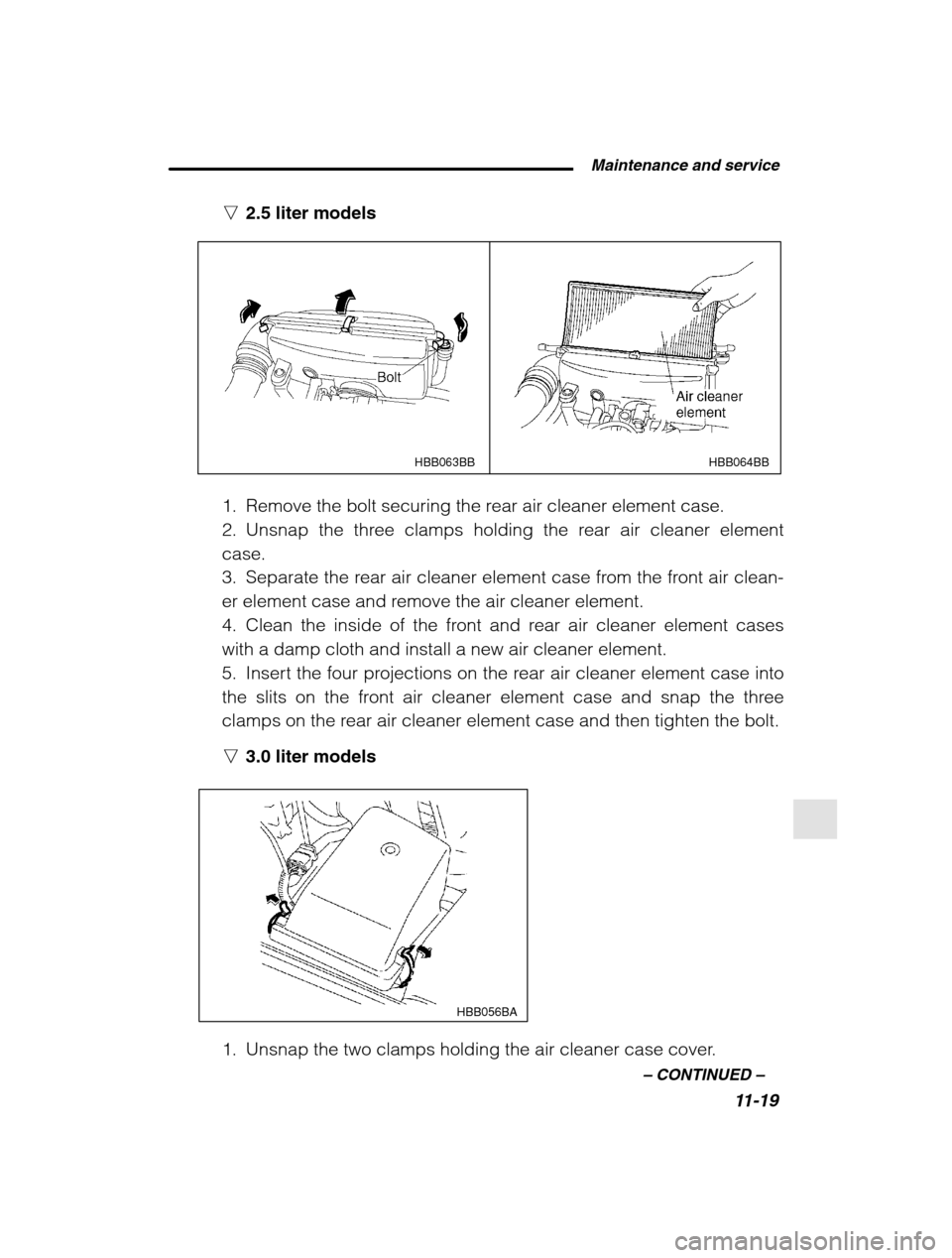
Maintenance and service11-19
–
CONTINUED –
n2.5 liter models
HBB064BB
HBB063BB
1. Remove the bolt securing the rear air cleaner element case.
2. Unsnap the three clamps holding the rear air cleaner elementcase.
3. Separate the rear air cleaner element case from the front air clean-
er element case and remove the air cleaner element.
4. Clean the inside of the front and rear air cleaner element caseswith a damp cloth and install a new air cleaner element.
5. Insert the four projections on the rear air cleaner element case into
the slits on the front air cleaner element case and snap the three
clamps on the rear air cleaner element case and then tighten the bolt. n 3.0 liter models
HBB056BA
1. Unsnap the two clamps holding the air cleaner case cover.
Page 390 of 466
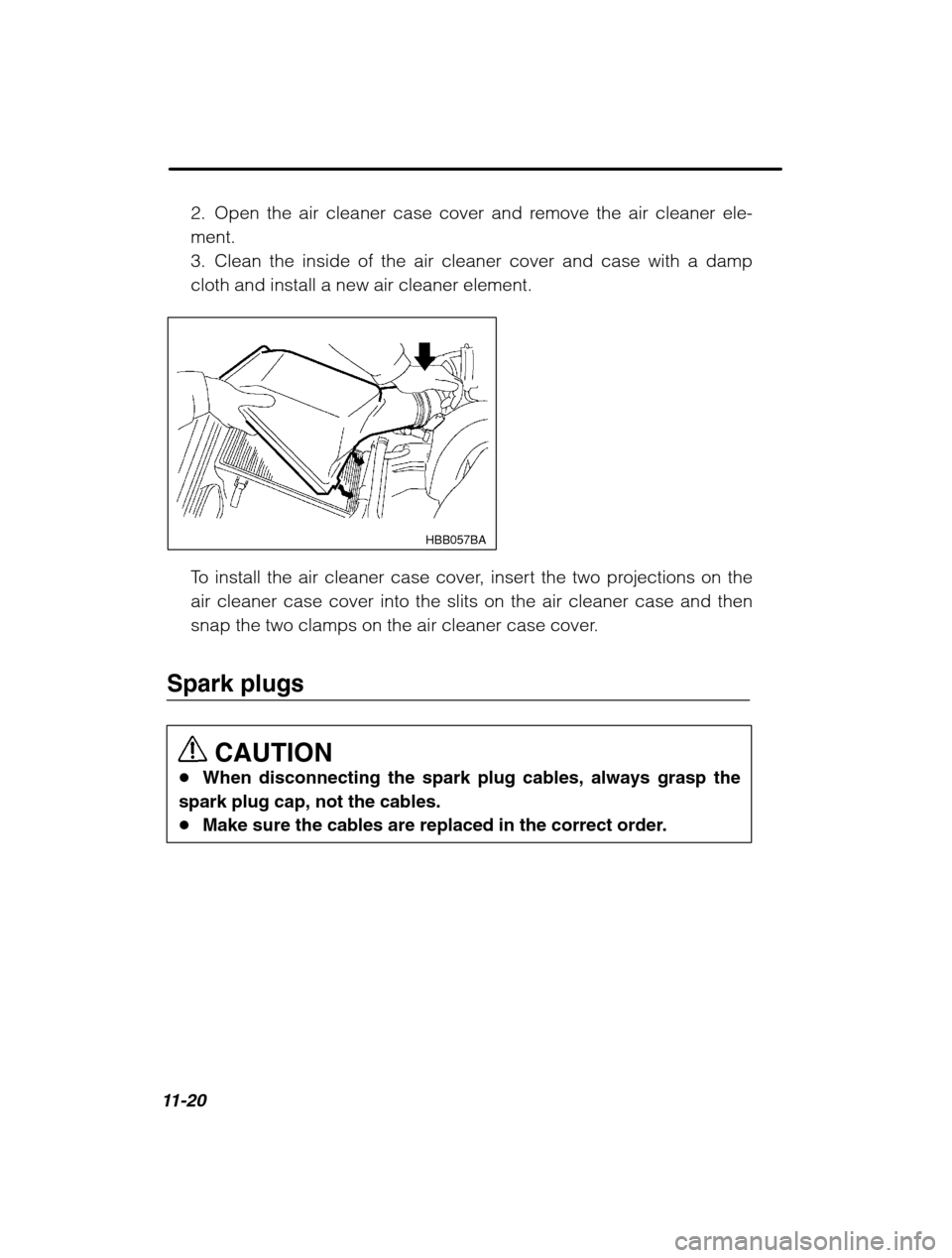
11-20
2. Open the air cleaner case cover and remove the air cleaner ele- ment.
3. Clean the inside of the air cleaner cover and case with a damp
cloth and install a new air cleaner element.
HBB057BA
To install the air cleaner case cover, insert the two projections on the air cleaner case cover into the slits on the air cleaner case and then
snap the two clamps on the air cleaner case cover.
Spark plugs
CAUTION
� When disconnecting the spark plug cables, always grasp the
spark plug cap, not the cables.� Make sure the cables are replaced in the correct order.